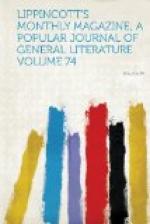Dublin swarms with soldiers, constabulary and police. The metropolitan police is divided into six divisions, each two hundred strong. Its men are, I believe, beyond a doubt the very finest in the world in point of physique. Numbers of them are six feet two or three inches high, and they are broad and athletic in proportion. Indeed, the magnificence of some of them who are detached for duty at certain “great confluences of human existence” is such that you see strangers standing and gaping at the giants in sheer amazement. The metropolitan police is quite distinct from the constabulary, and under a different chief.
Outside the bank, in College Green, is the celebrated statue of William III. Its location has been more than once changed, and it is now placed where the officer on guard at the bank can keep an eye upon it. This fearful object, which would make a Pradier or Chantrey shudder, is painted and gilt annually. It has long served as a bone of contention between Protestant and Papist, and has come off very badly several times at the hands of the latter—a circumstance which probably accounts for one of the horse’s legs being about a foot longer than the rest—half of that limb having been renewed after it had been lost in one of the many free fights in which this remarkable quadruped has seen service. The greatest proprietor of real estate in Dublin is the young earl of Pembroke, son of the late Right Hon. Sidney Herbert, so well known in connection with the Crimean war, who was created, shortly before his death, Lord Herbert of Lea. His estate, which is the most valuable in Ireland, comprises Merrion Square and all the most fashionable part of the Irish metropolis, and extends for several miles along the railway line running from Kingstown, the landing-place




